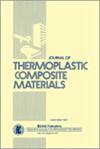用海泡石和石墨烯纳米片增强回收聚对苯二甲酸乙二酯/聚酰胺 11 的创新型混合纳米复合材料
IF 3.4
4区 材料科学
Q2 MATERIALS SCIENCE, COMPOSITES
引用次数: 0
摘要
本研究深入探讨了使用回收聚对苯二甲酸乙二酯(rPET)/聚酰胺(PA11)与sepiolite,并通过集成石墨烯纳米颗粒(GNP)增强的混合纳米复合材料的新型开发。使用同向旋转双螺杆挤出和注塑技术生产了五种不同的配方。最佳混合物(包括等量的海泡石和石墨烯纳米片(phr,每百分之一树脂))的拉伸强度为 54.5 兆帕,随着 GNP 含量从 0.2 phr 增加到 1 phr,取代海泡石后,拉伸强度增加了 46.5%,应变百分比增加了 59%。混合纳米复合材料的杨氏模量在 1020 至 1285 兆帕之间变化,表明其性能显著提高。含有 1 个短片海泡石和 1 个短片 GNP 的性能最好的杂化纳米复合材料(HNC-G1.0)的抗弯强度从 47.3 兆帕(HNC-G0.0)增加了 61.65%,达到 76.46 兆帕。相比之下,其弯曲模量从 HNC-G0.0 的 1730 兆帕增加到 2668 兆帕,显示出大幅改善。冲击强度也明显提高了 83%,从 HNC-G0.0(252.97 J/m)提高到 463.18 J/m(HNC-G1.0)。尽管机械性能有所提高,但热重分析(TGA)显示了纳米复合材料的热稳定性。同时,差示扫描量热法(DSC)证实熔化温度保持稳定,确保了加工条件的一致性。这项创新研究为 rPET 的先进应用,尤其是在汽车行业的应用铺平了道路。它标志着聚合物科学的重大进步,促进了可持续解决方案和高性能混合纳米复合材料的发展。本文章由计算机程序翻译,如有差异,请以英文原文为准。
Innovative hybrid nanocomposites of recycled polyethylene terephthalate/polyamide 11 reinforced with sepiolite and graphene nanoplatelets
This research delves into the novel development of hybrid nanocomposites using recycled polyethylene terephthalate (rPET)/polyamide (PA11) with sepiolite, enhanced by the integration of Graphene Nanoplatelets (GNP). Five different formulations were produced using co-rotating twin-screw extrusion and injection moulding techniques. The optimal blend, which includes equal amounts of sepiolite and graphene nanoplatelets (phr, 1 part per hundred resin each), exhibited a tensile strength of 54.5 MPa, representing an increase in tensile strength by 46.5% and an increase in percent strain by 59% as the GNP content increased from 0.2 to 1 phr, replacing sepiolite. Young’s modulus of hybrid nanocomposites varied between 1020 and 1285 MPa, indicating a significant enhancement. Flexural strength in the best-performing hybrid nanocomposite containing 1 phr of sepiolite and 1 phr of GNP (HNC-G1.0) increased by 61.65% to 76.46 MPa from 47.3 MPa (HNC-G0.0). In contrast, its flexural modulus reached 2668 MPa from HNC-G0.0 (1730 MPa), demonstrating substantial improvements. The impact strength also showed a notable 83% rise from HNC-G0.0 (252.97 J/m) to 463.18 J/m (HNC-G1.0). Despite these mechanical enhancements, Thermo Gravimetric Analysis (TGA) demonstrated the thermal stability of the nanocomposites. At the same time, Differential Scanning Calorimetry (DSC) confirmed that the melting temperature remained stable, ensuring consistent processing conditions. This innovative research paves the way for advanced applications of rPET, particularly in the automotive industry. It marks a significant advancement in polymer science, promoting sustainable solutions and high-performance hybrid nanocomposites.
求助全文
通过发布文献求助,成功后即可免费获取论文全文。
去求助
来源期刊

Journal of Thermoplastic Composite Materials
工程技术-材料科学:复合
CiteScore
8.00
自引率
18.20%
发文量
104
审稿时长
5.9 months
期刊介绍:
The Journal of Thermoplastic Composite Materials is a fully peer-reviewed international journal that publishes original research and review articles on polymers, nanocomposites, and particulate-, discontinuous-, and continuous-fiber-reinforced materials in the areas of processing, materials science, mechanics, durability, design, non destructive evaluation and manufacturing science. This journal is a member of the Committee on Publication Ethics (COPE).
 求助内容:
求助内容: 应助结果提醒方式:
应助结果提醒方式:


